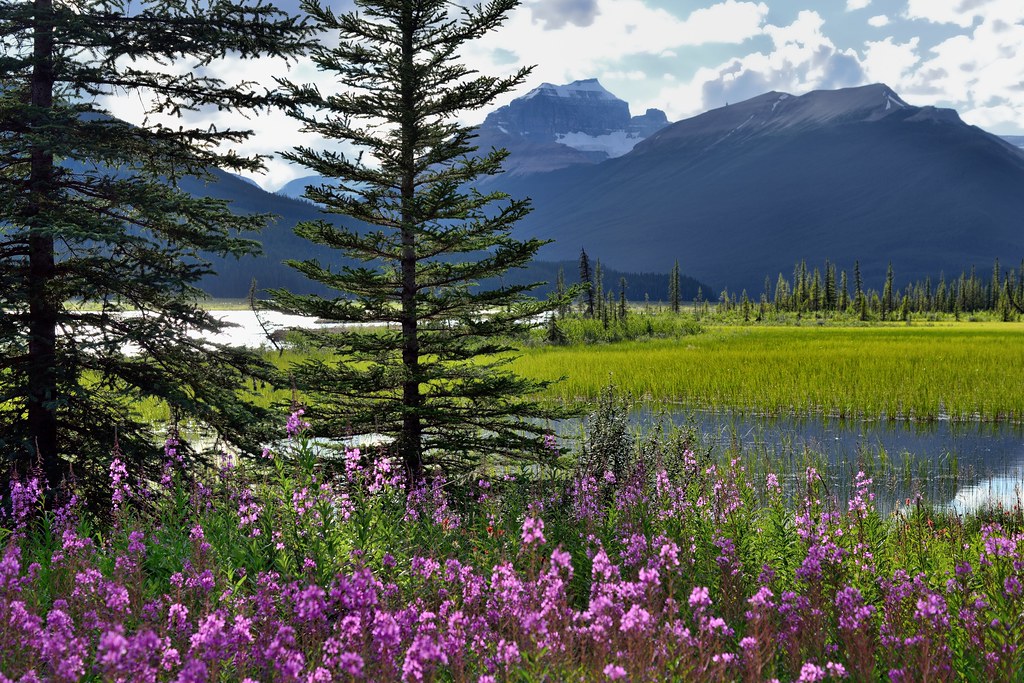#Columbia Icefield Range
Explore tagged Tumblr posts
Video
Looking at Wildflowers While Enjoying Views of Mount Saskatchewan (Banff National Park) by Mark Stevens Via Flickr: Here I backed up after finding this patch of fireweed. I wanted to include it in the image...kind of like the river and mountains were the idyllic backdrop to appreciate wildness of nature.
#Banff National Park#Blue Skies with Clouds#Canadian Rockies#Capture NX2 Edited#Cleopatra's Needle#Cloud Reflections on Water#Color Efex Pro#Columbia Icefield Range#Day 5#Fireweed#Grassy Meadow#Highway 93#Icefields Parkway#Lighthouse Tower#Looking WNW#Meadow#Mount Saskatchewan#Mountains#Mountains in Distance#Mountains off in Distance#Nature#Nikon D800E#North Saskatchewan River#Project365#Reflections#Reflections on Lake#Reflections on Water#River#Trees#Wildflowers
13 notes
·
View notes
Text










Banff National Park, AB (No. 7)
Throughout its history, Banff National Park has been shaped by tension between conservationist and land exploitation interests. The park was established on November 25, 1885, as Banff Hot Springs Reserve, in response to conflicting claims over who discovered hot springs there and who had the right to develop the hot springs for commercial interests. The conservationists prevailed when Prime Minister John A. Macdonald set aside the hot springs as a small protected reserve, which was later expanded to include Lake Louise and other areas extending north to the Columbia Icefield.
Archaeological evidence found at Vermilion Lakes indicates the first human activity in Banff to 10,300 BP. Prior to European contact, the area that is now Banff National Park was home to many Indigenous Peoples, including the Stoney Nakoda, Ktunaxa, Tsuut'ina, Kainaiwa, Piikani, Siksika, and Plains Cree. Indigenous Peoples utilized the area to hunt, fish, trade, travel, survey and practice culture. Many areas within Banff National Park are still known by their Stoney Nakoda names such as Lake Minnewanka and the Waputik Range. Cave and Basin served as an important cultural and spiritual site for the Stoney Nakoda.
With the admission of British Columbia to Canada on July 20, 1871, Canada agreed to build a transcontinental railroad. Construction of the railroad began in 1875, with Kicking Horse Pass chosen, over the more northerly Yellowhead Pass, as the route through the Canadian Rockies. Ten years later, on November 7, 1885, the last spike was driven in Craigellachie, British Columbia.
Source: Wikipedia
#Moose Meadows#Pilot Mountain#Copper Mountain#Bow Valley Parkway#aspen#travel#original photography#vacation#tourist attraction#landmark#landscape#countryside#Rocky Mountains#Canada#summer 2024#Alberta's Rockies#Canadian Rockies#flora#nature#forest#sub-alpine fir#Alberta#Banff National Park#pine#tree#woods#Hillsdale Meadow#Mount Ishbel#Mount Cockscomb#Castle Mountain
27 notes
·
View notes
Text
We arrived at the Columbia Icefields Experience around 2.30pm. The glacier we were due to walk on is the Athabasca Glacier. The guide described it as follows. Imagine that the Columbia Icefield is an enormous frozen lake of glacial ice on top of the mountain range. There are then numerous frozen rivers or glaciers that run off from this lake. The Athabasca Glacier is just one of these glaciers. After we arrived we boarded a coach to take us to the snow vehicle that would then take us onto the glacier. The vehicle was enormous but did its job getting there safely. Due the rain the surface of the glacier was quite slushy, the temperature had dropped considerably and there was a very strong wind. We got off the vehicle long enough to take a few pictures and then quickly got back on










4 notes
·
View notes
Text
A Journey Through Canada’s National Parks: Untamed Beauty and Adventure

Canada's national parks are a testament to the country's vast and varied landscapes, offering a refuge for nature lovers, adventurers, and those seeking solitude in the wild. This journey through some of the most breathtaking parks in the country showcases the untamed beauty and thrilling adventures that await in the great Canadian wilderness.
Banff National Park: The Crown Jewel of the Rockies
Banff National Park, Canada's first national park, is a must-visit for anyone exploring the country’s natural wonders. Located in the heart of the Canadian Rockies, Banff offers a stunning array of landscapes, from rugged mountain peaks to turquoise lakes. Visitors can hike the scenic trails around Lake Louise, drive the Icefields Parkway to witness the Athabasca Glacier, or soak in the natural hot springs. Banff’s charm lies not only in its majestic scenery but also in its accessibility, making it an ideal starting point for a journey through Canada’s national parks.
Jasper National Park: Wilderness at Its Wildest
Just north of Banff lies Jasper National Park, the largest national park in the Canadian Rockies. Jasper offers a more rugged and remote experience compared to Banff, with its vast wilderness areas, abundant wildlife, and fewer crowds. Adventure seekers can hike the trails to Mount Edith Cavell, paddle on Maligne Lake, or explore the Columbia Icefield. The park is also a designated Dark Sky Preserve, making it one of the best places in the world to stargaze and witness the northern lights.
Gros Morne National Park: The Untamed Beauty of Newfoundland
On the eastern edge of Canada, Gros Morne National Park in Newfoundland and Labrador offers a completely different landscape. This UNESCO World Heritage site features dramatic cliffs, fjords, and the ancient Long Range Mountains. Gros Morne is a paradise for hikers, with the challenging Gros Morne Mountain trail offering panoramic views of the park. Visitors can also take a boat tour through Western Brook Pond, a stunning fjord carved by glaciers, or explore the unique geological formations of the Tablelands.
Pacific Rim National Park Reserve: Coastal Wonders of British Columbia
Moving westward, the Pacific Rim National Park Reserve on Vancouver Island showcases the rugged beauty of Canada’s Pacific coast. The park is divided into three distinct units: Long Beach, the Broken Group Islands, and the West Coast Trail. Long Beach is perfect for surfing and beachcombing, while the Broken Group Islands offer kayaking adventures through a maze of islands and inlets. For those seeking a true challenge, the West Coast Trail is a multi-day trek along a historic trail that tests even the most seasoned hikers.
Fundy National Park: The Highest Tides in the World
On the opposite coast, Fundy National Park in New Brunswick is home to the highest tides in the world, a natural wonder that draws visitors from around the globe. The park’s dramatic coastline is shaped by the powerful tides of the Bay of Fundy, which rise and fall by up to 16 meters (52 feet) twice a day. Visitors can explore the sea floor during low tide, hike through the lush Acadian forest, or take a scenic drive along the Fundy Coastal Drive. The park is also a gateway to the Hopewell Rocks, where towering rock formations stand as a testament to the power of the tides.
Exploring Canada’s National Parks with Roomchai Limited
Embarking on a journey through Canada’s national parks is an adventure like no other, and Roomchai Limited is here to make your experience unforgettable. Our expertly curated travel packages include guided tours, comfortable accommodations, and all the necessary arrangements to explore these stunning landscapes. Whether you’re a seasoned adventurer or a nature lover seeking tranquility, Roomchai Limited offers customized itineraries that cater to your every need.
Conclusion
Canada’s national parks are a treasure trove of natural beauty and adventure, offering something for every traveler. From the towering peaks of the Rockies to the rugged coastline of the Pacific, and the ancient landscapes of Newfoundland, each park tells its own story of Canada’s untamed wilderness. With Roomchai Limited, you can embark on this journey with confidence, knowing that every detail has been taken care of, leaving you free to explore, discover, and create lasting memories.
#roomchailimited#travel#traveltips#dhakatravel#bangladeshitravelers#travelagencies#canada#national park
0 notes
Text
Experience the Beauty of Canada: Your Complete Travel Guide
Your ultimate travel and tour guide in Canada to exploring the breathtaking beauty of Canada. From the majestic Rocky Mountains to the stunning coastal landscapes of Nova Scotia, Canada offers a diverse range of experiences for every traveller.
Whether you're an adventure enthusiast, a nature lover, or a culture seeker, Canada has something special in store for you.
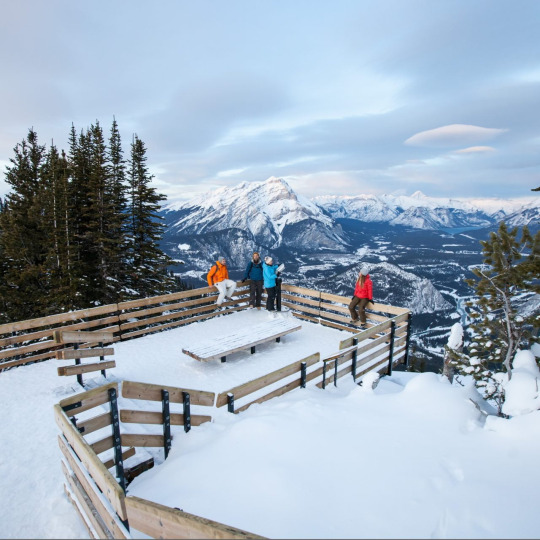
Discover the Diversity of Canada
Explore Natural Wonders
Canada boasts some of the most awe-inspiring natural wonders in the world. Visit Banff National Park in Alberta to witness turquoise lakes, glaciers, and rugged mountain peaks. Take a scenic drive along the Icefields Parkway for panoramic views of pristine wilderness. Don't miss the chance to see Niagara Falls, one of the most iconic waterfalls on the planet, located on the border between Ontario and New York.
Embrace Outdoor Adventures
For adrenaline junkies, Canada offers a plethora of outdoor activities year-round. Go skiing or snowboarding in Whistler, British Columbia, renowned for its world-class slopes. In the summer, embark on a thrilling whitewater rafting expedition in the rivers of Quebec or go hiking in the remote Yukon territory.
Experience Vibrant Cities
Visit Cultural Hotspots
Immerse yourself in the vibrant cultural scene of Canada's cities. Explore the multicultural neighbourhoods of Toronto, where you can sample diverse cuisines from around the world. Wander through the historic streets of Quebec City and marvel at its European charm and architecture. Experience the vibrant arts scene in Vancouver, home to numerous galleries, theatres, and music venues.
Indulge in Culinary Delights
Canada's culinary scene is as diverse as its landscape. From fresh seafood on the east coast to farm-to-table cuisine in the prairies, there's something to tantalise every palate. Don't forget to try iconic Canadian dishes like poutine, maple syrup-infused treats, and butter tarts.
Practical Tips for Travelers
Weather Considerations
Canada experiences distinct seasons, so pack accordingly. Winters can be harsh, especially in the northern regions, so bundle up with layers and winter gear. Summers can be warm and humid, particularly in central and eastern Canada, so lightweight clothing is essential.
Transportation Options
Getting around Canada is easy thanks to its well-developed transportation network. Renting a car is a convenient option for exploring remote areas, while public transportation is readily available in major cities. Domestic flights are also available for long-distance travel between provinces.
Embark on the adventure of a lifetime and let Travelling Chicken guide you through the wonders of Canada. Whether you're seeking adrenaline-pumping activities or serene natural landscapes, Canada promises an unforgettable experience for every traveller. Plan your trip today and discover the beauty of the Great White North! Contact us now for more information!
0 notes
Text
Five Must-Visit Locations in Canada for an Unforgettable Experience
Canada, known for its stunning natural landscapes, vibrant cities, and rich cultural diversity, offers a wealth of experiences for travelers. From the rugged Rocky Mountains to the charming streets of Quebec City, this vast country has something to offer every type of traveler. Here are five must-visit locations in Canada that promise unforgettable memories and experiences.

Banff National Park, Alberta Nestled in the heart of the Canadian Rockies, Banff National Park is a true natural wonder. With its turquoise lakes, towering mountain peaks, and abundant wildlife, this UNESCO World Heritage site offers some of the most breathtaking scenery in the world. Visitors can explore the park through a network of hiking trails, go wildlife spotting, or take a leisurely drive along the famous Icefields Parkway. Don't forget to relax in the soothing Banff Upper Hot Springs after a day of adventure.
Vancouver, British Columbia As one of the most cosmopolitan cities in Canada, Vancouver boasts a unique blend of urban sophistication and natural beauty. Surrounded by mountains and the Pacific Ocean, the city offers a wide range of activities, from strolling along the famous Stanley Park seawall to exploring the vibrant neighborhoods of Granville Island. For a taste of the diverse local cuisine, visit the Granville Island Public Market or enjoy an array of international restaurants in the city center.
Old Quebec City, Quebec Steeped in history and Old World charm, Quebec City is like a piece of Europe in North America. Its cobbled streets, historic architecture, and the iconic Chateau Frontenac create an enchanting atmosphere. Take a leisurely walk through the quaint streets of Old Town, explore the centuries-old fortifications, and don't miss a visit to the Plains of Abraham for a taste of Canadian history. Enjoy delicious French-inspired cuisine in one of the city's many bistros.
Niagara Falls, Ontario One of the most iconic natural wonders in the world, Niagara Falls is a must-see for any traveler to Canada. Witnessing the sheer power and beauty of the falls up close is an awe-inspiring experience. Take a boat tour to get close to the cascading waters, or explore the scenic trails of Niagara Glen Nature Reserve for a different perspective. The nearby town of Niagara-on-the-Lake offers charming streets, wineries, and a rich arts scene.
Peggy's Cove, Nova Scotia For a taste of maritime charm and rugged coastal beauty, Peggy's Cove in Nova Scotia is a must-visit destination. This quaint fishing village, with its picturesque lighthouse perched on granite cliffs, is a photographer's dream. Explore the narrow, winding streets lined with colorful houses and enjoy fresh seafood at one of the local eateries. The nearby Swissair Flight 111 Memorial is a poignant reminder of history.
Conclusion
Canada's diverse landscapes and vibrant cities offer a wealth of experiences for travelers seeking adventure, relaxation, or cultural immersion. Whether you're captivated by the majesty of the Rockies, charmed by the streets of Old Quebec, or inspired by the power of Niagara Falls, Canada has something for everyone. These five must-visit locations provide just a glimpse into the incredible experiences that await in this vast and beautiful country. So pack your bags and get ready to embark on an unforgettable Canadian adventure!
Visa Service In Delhi
Delhi Visa Agent Contact Number
Best Visa Agent In Delhi
Tourist Visa Agent In Delhi
>> >>
0 notes
Photo

Wednesday Winter Tip #3: Bracket! Exposure bracketing is a helpful tool whenever time is of the essence. It is a particularly helpful feature for winter photography when the tonal ranges are much greater and often exceed the capabilities of the sensor. Bracketing means getting brighter and darker versions of the same scene, typically by altering shutter speed. This gives you a safety net to properly expose ephemeral, snowy scenes, keeps you from fiddling with your camera settings in the cold, and provides you with the extra frames you might need should blending be required in post. This one was taken as the last light was falling on the seracs of the North Twin, on the Columbia Icefield. — view on Instagram https://ift.tt/2JG6sgI
119 notes
·
View notes
Video
Bow River (Explored Feb. 25, 2021) by Tim Lumley Via Flickr: The Bow River exits the resort town of Banff in the Canadian Rockies through a gap in Mount Rundle. Mt. Rundle is a long mountain, about 7.5 mi, with seven distinct sub-peaks. It actually looks more like a small mountain range than a distinct mountain. The base of Rungle1 is on the right in this image. The Bow River begins north of here near the Wapta Icefield located on the Continental Divide in the provinces of British Columbia and Alberta. Water flows from here through the Alberta foothills onto the Canadian Prairies, to the Oldman River, to South Saskatchewan River and ultimately into the Hudson Bay. Banff, Bow River Valley, Banff National Park, Alberta, Canada. Elevation 4,479 ft. August 14, 2019.
#Alberta#Banff National Park#Canada#Canadian National Park#Glacier National Park#Montana#landscape photography#national park#nature photography#naturescape#outdoors#park#religious#residential#Banff National Park of Canada
15 notes
·
View notes
Text
Susan Alcorn Quintet — Pedernal (Relative Pitch Records)

Pedernal by Susan Alcorn Quintet
Susan Alcorn has created a new vocabulary for the pedal steel guitar, an instrument closely associated with the country & western genre. The composer and steel player started out playing in Texas country & western bands before immersing herself in free jazz, modern classical and musical traditions from outside North America. Her playing is unique, a culmination of her experiences and influences: equally melodic and atonal, at times terse and at others languorous. She cuts a wide swathe, stylistically, yet is evenly eloquent across the broad range she inhabits.
With Pedernal, Alcorn plays the role of composer, performer and band leader, her debut as the latter after decades of solo, duo, and side-woman outings. Adding her six strings to Alcorn’s compositions is guitarist Mary Halvorson, a long-time collaborator. Alcorn’s pedal steel is the grounding force within Halvorson’s own octet, as can be heard on the Away With You record. Joining on double bass is another frequent associate, the Baltimore-based Michael Formanek (Alcorn is also currently a Charm City resident). Ryan Sawyer, who plays with Alcorn and Halvorson on Nate Wooley’s Columbia Icefield album, lends his drumming talents to the proceedings. Rounding out the quintet, Mark Feldman wields the violin, as unique an instrument within the jazz idiom as the pedal steel.
Alcorn and her team of crack improvisors imbue the quintet concept with a sense of airiness without coming across as fragile or dull. Whereas a less well-orchestrated combo might seem crowded or even step over each other, this quintet seems to sense when to stay true to Alcorn’s compositions and when to slip out and be a little daring. Halvorson and Alcorn, in particular, are nearly synchronous when they’re not playfully dancing around each other or pulling off a solo. Feldman’s violin is the perfect foil for those two. Whether he is soaring or scrabbling about, he has a keen sense of what energy each moment requires.
It's quite clear that Alcorn has not left her country roots behind, as evinced within the first bluesy moments of Pedernal. The album, and its eponymous opening piece, were named after the mesa in New Mexico near where the composer holed up in retreat and wrote. Those first few bars conjure up images of the mountain, which painter Georgia O’Keeffe made famous through many of her works. The breathtaking vista was inspirational for both women. The elegance and immensity are carried through not only Alcorn’s compositions but are felt in the performance of the quintet, and of each player. If it’s possible for a landscape to reverberate within a recording, this is definitely the phenomenon at play on Pedernal.
Bryon Hayes
#susan alcorn#susan alcorn quintet#pedernal#bryon hayes#albumreview#dusted magazine#pedal steel#mary halvorson#michael formanek#ryan sawyer#mark feldman#country#jazz#free jazz
5 notes
·
View notes
Text
Thunderwater Lake Route (heli-hiking)
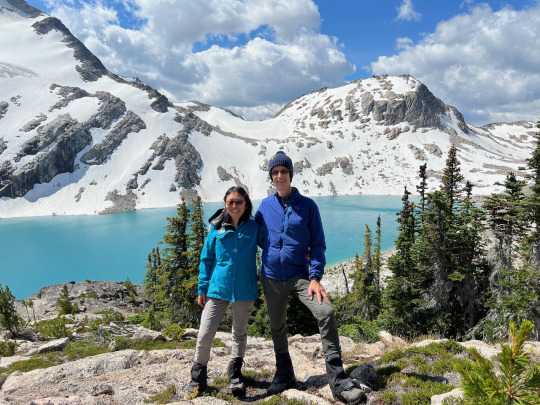
Date: 08/02/2022 Country: Canada Region: The Bugaboos (in Purcell Mountain Range), British Columbia Trailhead: None (cross-country hiking) Length: 6 miles Elevation gain: 2,600 ft
This was our second heli-hike, and it confirmed our first enthusiastic impression from the previous day. As a mode of hiking, it offers a plethora of advantages: A) You quickly get to remote locations; B) you are transported above the tree line, so hiking starts and ends with views; C) There is never an in-and out trail, but it goes from A-B with ever-changing scenery; D) Since you find yourself in scenic spots both much earlier and much later in the day than would be possible on regular day-hikes, you can catch the best light conditions for photography in spectacular surroundings high up; E) The hikes are mostly cross-country, away from trails, which means that the flora and fauna are untrammeled and plentiful; F) And finally, you enjoy near complete solitude up there among the glaciers and peaks (except for the fellow hikers in your small group).
Oh, there’s one more bonus (though this may be a matter of personal taste): We never knew exactly where we were would be dropped off at any given day. The guides have a meeting in the morning, and--depending on the weather forecast, the conditions on the ground, the participants’ hiking proficiency, as well as other factors such as wildlife activity--they decide each group’s route for the day. We as clients are simply herded into the heli, and then we take off to parts unknown--at least unknown to us. Every day thus starts with a surprise.
This morning, after a short 5-minute flight, we were dropped off on a ridge across from a yellow limestone wall dramatically lit up by the slanting sun.
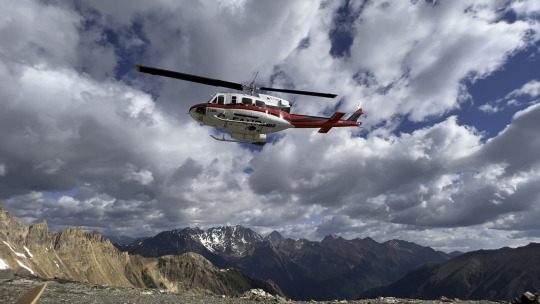
The heli’s take-off pressed us into the ground with its powerful rotor wash. Then we got up, dusted ourselves off, and took a good look at the surroundings. Right below us, we spied the first of five scenic lakes strung along today’s route. However, we were headed in the opposite direction from that lake, and as soon as we turned around a ledge to start descending a rocky slope, a sharp wind sweeping down from the icefields sprung into our faces, reminding us that we were in truly wild territory.
A little later, lake #2 came into view, still mostly frozen, and covered with a thin layer of red algae dubbed “watermelon snow.”
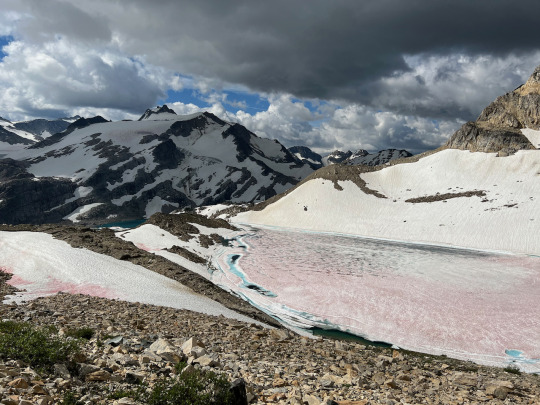
This type of algae, named Chlamydomonas Nivalis, lives on snow, where it produces a secondary, red pigment to protect the chlorophyll from the sun’s UV light, like a “sunscreen.” Nature is amazing!
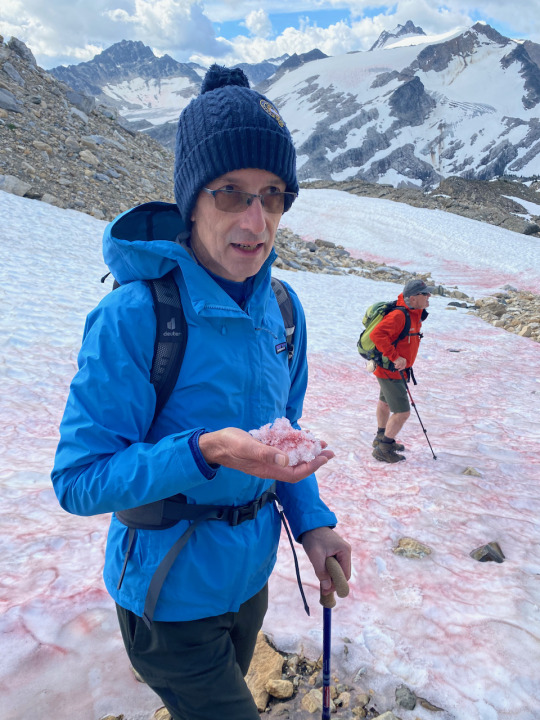
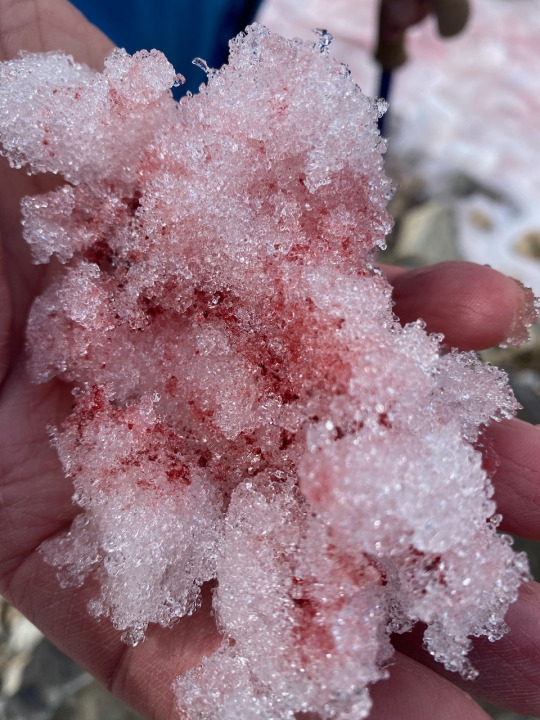
We continued scrambling for another hour, navigating a steep scree slope, crossing a boulder field, and following the steps cut by Hans into a tilted snow field. In this way we slowly approached Thunderwater Lake. After ascending an extended snowfield, we topped the comb of the ridge and then looked down upon the luminous lake, ringed by snow-covered mountains--high-alpine views at their best.
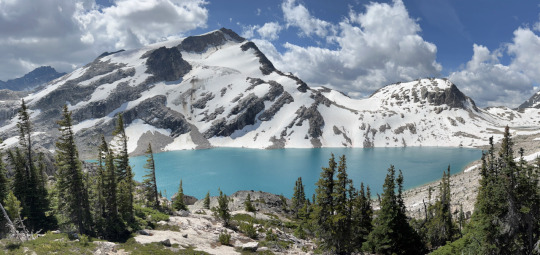
Following the shore of Thunderwater Lake, we proceeded another half-mile uphill until we arrived at lake #4, which was 50% covered with chunks of ice coated in watermelon snow. Here we had a most delightful picnic lunch, tucking into the sandwiches provided by the lodge while clouds chased each other across a blue sky, with corresponding patterns of light and shade gliding over the rock, ice, and water.
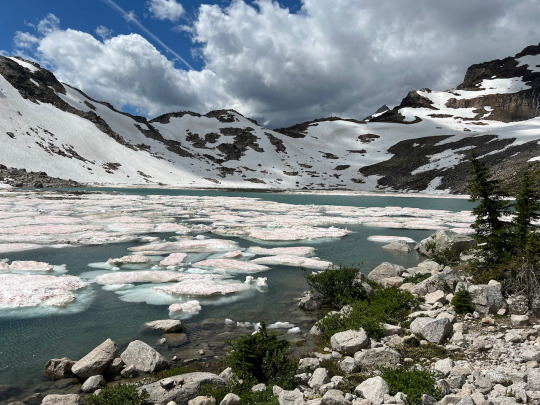
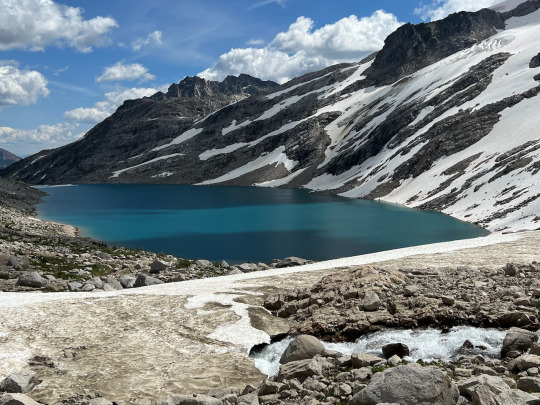
The next segment of our hike included a long uphill slog over a steep snowfield. Again, the icepick came out, as Hans cut steps into the hardened snow to create an improvised stairway. One member of our group didn’t have poles and kept falling down, an object lesson in bringing the right equipment for this kind of territory.
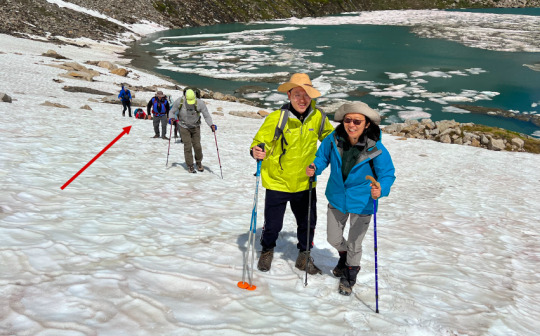
The final portion of the hike required navigating a boulder field, and here we proceeded very slowly, picking our individual way by hopping from rock to rock. Our peculiar hiking technique, i.e. holding hands while using the opposite arm to support supporting ourselves on hiking poles, came in very handy--literally--in this stretch of the hike. We are such a well-practiced team using this technique that we can pretty much outpace everybody, except our guide. After about an hour of such scrambling, we arrived at lake #5, a partially frozen mountain tarn cradled in a small depression at the foot of a hanging glacier.
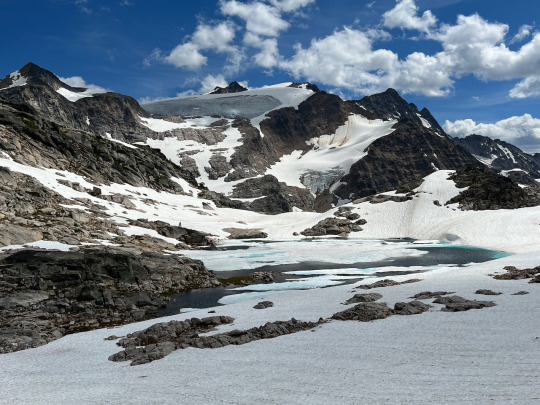
Sliding down to the lake sitting on our bottoms or skidding along on our boots was great fun. Then we took our time for another snack break, watering up, and enjoying the stunning scenery with clear views across the lake to the distant snow-clad peaks.
Half an hour later, the chopper’s percussive clatter suddenly echoed from the surrounding cliffs, and then the heli swung into view, banking steeply to the left, making a turn and then coming to rest on a nearby natural snow platform.

Our pilot, Jens, had arrived early, and while we were heading over to the landing site, he cut the engine and sauntered toward us, evidently in no hurry and happy to pose for pictures. A wonderful day thus came to an apt conclusion.
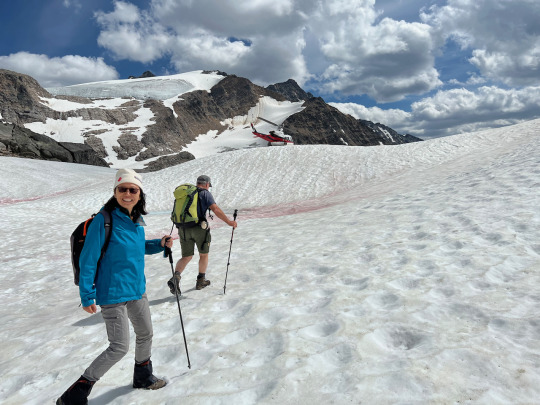
1 note
·
View note
Video
Mount Saskatchewan and Cleopatra’s Needle (Icefields Parkway) by Mark Stevens Via Flickr: A view I'd seen many a year ago and definitely had to capture again! This day I found the weather much better with the blue skies and clouds all around. I kept a wider angle view, wanting to include the waters of the North Saskatchewan River.
#Banff National Park#Blue Skies with Clouds#Canadian Rockies#Capture NX2 Edited#Cleopatra’s Needle#Color Efex Pro#Columbia Icefield Range#Day 5#Glacier#Highway 93#Hillside of Trees#Icefields Parkway#Lighthouse Tower#Looking NW#Mount Saskatchewan#Mountains#Mountains in Distance#Mountains off in Distance#Nature#Nikon D800E#North Saskatchewan River#Portfolio#Project365#River#Trees#Alberta#Canada#flickr
14 notes
·
View notes
Text










Jasper National Park, AB (No. 12)
The Athabasca River originates in Jasper National Park, in Lake Providence at the toe of the Columbia Glacier within the Columbia Icefield, between Mount Columbia, Snow Dome, and the Winston Churchill Range, at an elevation of approximately 1,600 metres (5,200 ft). It travels 1,231 km (765 mi) before draining into the Peace-Athabasca Delta near Lake Athabasca south of Fort Chipewyan. From there, its waters flow north as Rivière des Rochers, then join the Peace River to form the Slave River, which empties into the Great Slave Lake and discharges through the Mackenzie River system into the Arctic Ocean. The cumulative drainage area is 95,300 km2 (36,800 sq mi).
The river flows along icefields and through gorges, offering wildlife habitat on its shores and in adjacent marshes. Throughout its course, it flows through or adjacent to numerous��national and provincial parks, including Jasper National Park, Fort Assiniboine Sandhills Wildland Provincial Park, Hubert Lake Wildland Provincial Park, La Biche River Wildland Provincial Park, Grand Rapids Wildland Provincial Park, Richardson Wildland Provincial Park, and Wood Buffalo National Park. Its course is marked by rapids, impeding navigation southwest of Fort McMurray.
Numerous communities are located on the banks of the Athabasca River, including Jasper, Brule, Entrance, Hinton, Whitecourt, Fort Assiniboine, Smith, Athabasca, Fort McMurray, and Fort McKay.
Source: Wikipedia
#Rocky Mountains#Northern Rockies#Alberta's Rockies#travel#original photography#vacation#tourist attraction#landmark#landscape#summer 2023#Canada#woods#forest#reflection#flora#nature#countryside#fir#pine#Jasper National Park#UNESCO World Heritage Site#Yellowhead Highway#Athabasca River
21 notes
·
View notes
Text
Alberta Canada David Thomson Traveler's Path and also the Aurum Lodge- A Golden Nugget
AN ELECTRIFYING DRIVE When a person discusses Alberta Canad , I instantly think about Banff, Lake Louise, as well as Jasper. I am not most likely to suggest with you that the above three are not lovely, nevertheless, if you are seeking Alberta's finest concealed, take a drive along the David Thompson Traveler's Path (Freeway 11 on maps). You will not be sorry, specifically if you are looking for that best as well as serene, enchanting location. That was David Thompson anyways? He simply takes place to be among Canada's essential geographers, as well as it was he, that in between the years 1806-08 took a trip up the North Saskatchewan River and also uncovered the Athabasca Travel through the Continental Separate.

After experiencing the magnificent drive, we comprehended exactly how proper it was to call the freeway hereafter terrific Canadian. By the way, the path expands from Stettler to the Saskatchewan River Crossing at the joint of freeway 93, within the limits of the Banff National Forest. drive for my other half, and also myself was the one and also a fifty percent hrs from the community of Rocky Hill Home to our location, the Aurum Lodge. The large appeal, as well as enigma of Crescent Falls, Bighorn Canyon, Abraham Lake and also the thick bordering woodlands, approached the analysis of a great item of verse. Our spirits raised to elevations we might never have visualized! If you have the moment, do not neglect to take a look at The Rocky Hill Historic Website Of Canada. An ONE-OF-A-KIND PLACE IN NATURE AND ALSO WILD The trademark scene, and also one I can still plainly imagine, is when we came close to the Aurum Lodge snuggled along Freeway 11 neglecting the sensational elegance of Abraham Lake. As a musician, my spouse can not assist herself from saying every adjective in her English and also French vocabularies in defining these marvelous sights! Including in our enjoyment was that we were checking out a lodge whose place as well as environments had the excellent active ingredients to improve the mood of love. From the minute we strolled right into the lodge as well as cleared up right into our sizable area, my spouse and also I have brushed up away with the incomparable sight of the blue-green shade of Abraham Lake as well as the hill environments of Mount Stelfox, Elliot Top, as well as Mount. Michener. Swiss birthed innkeepers Alan and also Madeleine Ernst initially made their method to Canada from Singapore in 1989, after having actually taken a trip and also operated in over 40 nations. In 1999 they determined to make their residence in Alberta in an area that is a half hr repel from the closest district, Nordegg and also beside Banff National forest. In 2000' their doors were opened up to invite the lodge's initial visitors. What is most distinct as well as preferable regarding the all-season Aurum Lodge is that it lies in nature and also wild that is easily obtainable, in addition to being abundant in the background and also indigenous society. The primary approach of its proprietors is that their activities are driven by ecological reputation as long as earnings. Because of this, they have actually considered the influence of the lodge on its environments, visual appeals, product selection, waste decrease, effective layout, audio control, warmth retention, environment control, passive solar, power usage, electrical energy manufacturing, contamination, waste administration, transport, and also water and also administration. Alan, a previous Swiss lender as well as not, as I had thought of, a designer or designer, did an outstanding quantity of research study, as well as it was he that developed this eco-sensitive lodge.

Are the areas charming? You wager they are, when you consider their privacy, space, illumination, convenience, atmosphere, as well as indeed; there is also a space with a Jacuzzi for that unique event. For convenience, every one of the lodge's scrupulously comfortable tidy six areas featured orthopedic health and wellness cushions, down quilts and also cushions (artificial bed linens is readily available on demand), exclusive bathrooms with tub/shower. There are likewise two housekeeping homes in addition to a 2- room apartment or condo that comes full with fridge/freezer, cooktop, microwave, and also a restroom with shower. These systems are different from the lodge as well as have no access to the centers of the lodge (e.g., usual locations or dishes and also no housemaid solution). We can not aid yet really feel the spirit of the Mountain ranges executing every one of the spaces in addition to the lodge's environments. Incidentally, if you are questioning what the name Aurum indicates, Alan advised me that it is the Latin term for gold. The lodge's proprietors strongly think that there are worths in life, which can not exist in financial terms, however, are similarly valuable.
Among the best praises the proprietors got was from a center aged pair that came below to take a break as well as entrusted the remark that their remain had actually been unique since it was the very first time in years, they had a possibility to rest,
unwind as well as speak, without being disrupted by phones, youngsters, good friends or TELEVISION. That practically summarize what the Aurum Lodge is everything! EATING Any uncertainties we might have had relating to morning meal or the night "table d'hôte" were promptly eliminated when we feasted on every nibble of Madeleine's delightfully ready dishes. Both were passionate, yummy as well as wholesome. On top of that, the hosts were charitable in using at supper free of charge a glass of wine and also beer-something not also usual amongst inns of a comparable nature.
Morning meal is consisted of with the lodge spaces just as well as supper is offered by advancement notification for visitors in the lodge. The eating routine consisted of the conference with visitors from all edges of the world leading to some extremely computer animated discussions-one a lot more reason that our keep was so wonderful. Undoubtedly the Aurum Lodge is a gold nugget locate! EXTRA INFO Calling Aurum Lodge Box 76, Nordegg, Abdominal Muscle, T0M 2H0, Canada Telephone: 1-403-721 2117 Fax: 1-403-7212118 Area: 40km E of Banff National Forest. Details Concerning The Location's Tasks The Lodge's Selection of 4 Period Tasks Tasks Trekking, cycling, riding, canoeing, climbing up, x-country ski, snowshoeing, winter-hiking, ice-climbing, pet sledding, scenic tours right into the National Parks as well as to historical websites. The lodge lies near to Banff National Forest Border as well as Mistaya Canyon, Kootenay Plains Ecological Book, indigenous websites and also leader cabins, Bighorn Dam as well as site visitor info center, Nordegg historical town-site, mine trips and also a historical golf links,
Crescent Falls on Bighorn River, various trailheads, Jasper National forest Border, Columbia Icefield, Bow Top as well as Peyto Lake in Banff National Forest, Ram River Falls and also websites along forestry trunk roadways. Wedding events The lodge is readily available for a tiny, intimate wedding event for pairs trying to find a no-fuss occasion within an all-natural setup. Standard as well as Lily Goldman are a distinct couple group, author and also watercolorist,
that create as well as repaint concerning charming locations, whose short articles as well as art- the job can see on several Net websites including their very own- as well as They have worked together with some convention bureaus and also several Public Relations business.
1 note
·
View note
Text
Best places to visit in Canada
Canada is well known for its clean and fresh landscape. Its vast mountain ranges, diverse mix of people and rich history attract tourists from all over the world. It is the second largest country globally and has an area of 9.8 million square kilometres.
There are many local spots with beautiful views that you can enjoy. The best way to see local destinations is to drive your own car. You can plan your road trips in Canada to these beautiful destinations. There are stops and hot spots along the way for you to take a rest during your road trips. If you plan to drive on your own, you should have all the necessary documents. It is advisable to keep your International Driving permit, your National Driving Licence, and all the necessary documents at hand. You must follow all the road rules while driving. Following the rules ensures your safety and the safety of others as well.
Icefield Parkway in Alberta, Banff to Vancouver via the Trans-Canada Highway, the Sea-to-Sky Highway of British Columbia, and the Grasslands National Park of Saskatchewan are some of the best road trip routes in Canada. There are so many other road trip destinations that you can plan to get on in Canada
As Canada is home to people of different cultures, there are many festivals and cultural attractions throughout the year. The people of this country are extremely tidy and love their environment. The culture of Canada is quite Eurocentric; their way of lifestyle comes from France and Britain. When you visit, you get a taste of Europe while being in an American country.
What are the best places to visit in Canada?
The Rocky Mountains, Okanagan Valley, and the cities of Vancouver and Victoria are some of the best tourist attractions in Western Canada. While in Central Canada, Niagara Falls, Ottawa, Toronto, Quebec City, and Montreal are some of the best destinations for tourists.
If you plan to venture to the Atlantic Provinces of Canada in the east, Gros Morne National Park and the cities of Halifax and St John’s are some of the best destinations to visit.
Niagara Falls
Niagara Falls is a very famous tourist spot in Canada. Millions of tourists from all over the world visit this falls every year. It is an hour's drive from Toronto, along the border of America, this fall drops about 57 meters.
There are several key points near the fall, from which you can see it from a very close distance. Visitors can enjoy a walk on Clifton Hill in Niagara that leads to the falls and the gorge. Other popular activities include a cruise to the base of the falls and a trip to the Skylon Tower for an aerial view of the place.
Banff National Park and the Rocky Mountains
The Banff National park, situated at the heart of the glorious Rock Mountain, lies in the province of Alberta. There are snow-capped peaks, turquoise lakes, and glaciers in the park. You can either drive your own car or go hiking to enjoy the scenic beauty of this park.
The main attraction of this park is Lake Louise; here, the clear green waters reflect the surrounding mountains and glaciers. Visitors like to stroll along the shores of the lake. At a short distance from this lake lies Moraine Lake, another impressive lake with beautiful surroundings.
Another major attraction of this place is the unforgettable long drive on the Icefields Parkway, which runs from Lake Louise to Jasper.
Old Quebec, also known as Vieux-Quebec
Rich in museums and historic landmarks, Old Quebec is a neighbourhood in Quebec City. Old Quebec has been designated a UNESCO World Heritage Site since 1985. This area contains the most historic buildings in the city.
The Upper Town is located on 100-meter-high cliffs and is known for several tourist spots. The Citadel, the Plains of Abraham, Parque Historique de L’Artillerie, and Place d’Armes, are some of the famous tourist spots. The Lower Town, situated on the banks of River Lawrence, is the site of the original settlement.
The place is home to the Fairmont Le Château Frontenac and numerous other treasures.
Other attractions of the place are its museums. The Musée de la Civilization is a famous museum of this place, and Rue du trésor, where artists display their work, are some of the other places you can consider visiting.
Whistler
The main attraction of this place is the famous ski resort, Whistler Blackcomb. Whistler, located in the province of Black Columbia, is a two-hour drive from Vancouver.
Whistler is the ideal destination for all kinds of winter sport.
In 2010, it was also selected as one of the locations for the 2010 Winter Olympic Games. This area offers one of the most beautiful mountain sceneries. These days it has become famous for its popular summer activities, including golf and mountain biking, thus making it a year-round tourist destination.
Ottawa’s Parliament Hill
Ottawa's Parliament stands just above the Ottawa River. The place is adorned by Neo-Gothic-style Parliament buildings built in the 19th century.
The most attractive feature of the place is the peace tower, which acts as a divider between the House of Commons and the Senate. In front of the Parliament is the Centennial Flame, which was first lit in 1967; it works with natural gas. It is surrounded by a fountain that never freezes. The money thrown away serves as a donation to people with disabilities.
Old Montreal
If you want to do some shopping and then have a lovely dinner, Old Montreal is the ideal place to do so. It is a vibrant city lined up with lovely historic buildings.
Some of the famous tourist spots include the landmark Marché Bonsecours in the old town building, Rue Bonsecours, the magnificent Notre-Dame Basilica, and the City Hall of the 1870s.
Toronto
Toronto is the largest city in Canada. Toronto is the main cultural attraction of the country. Some of the best Broadway shows, symphony, opera, and ballet are from Toronto.
Toronto also holds one of the country's major landmarks, the CN Tower.
These are just a few of the best tourist spots in Canada. There is a lot much to visit and see in this country. With all the beautiful mountains, waterfalls, and coasts, Canada is one of the best places to explore the beauty of nature.
Although practically all of these tourist attractions are accessible by public transportation, as a tourist or foreign visitor, it is usually a good idea to rent a car. This allows you to travel around according to your whims and preferences, allowing you to make as many stops as you like, even for something as simple as a cute little photograph and making memories, without the driver telepathically trying to pressure you to hurry or hiding their frustration each time you ask them to stop. There is, however, a perfectly simple solution to this minor snag that threatens to spoil your holiday mood while you’re in Canada: an International Driving License Canada. You may apply for an international driving licence and acquire your international drivers permit online with the help of ITCA in just a few simple clicks. With this International Driving Permit Canada in hand, you can visit these tourist attractions wherever and whenever you choose and desire.
0 notes
Text
Day 29. Canmore, AB to Jasper, AB. 196 miles.
I head for Jasper today along the Icefield Parkway with the many others who have the same idea. I begin to dislike other people and pay a penance for this.
This is the coldest morning so far and I have all my layers on. I double wrap my bandana and my new gloves are in operation too.
I am ready for Banff when it comes along in 20 minutes and I stand in the welcome warmth of White Bark Cafe to order my yogurt, berries and granola with oatmeal muffin and coffee on the side.
Banff is a ski resort, out of season with cafes and lodges catering for hikers, mountain bikers and elderly wanderers like me.
The snowboarders get around on skateboards keeping up the balance skills they will need when the snow falls, not long if I go by the temperature of the day.
Seedy looking sparrows scrabble for scraps and a pair of dogs bark at my squeaking boots but it's fun watching the world go by.
Back on Highway 1 for a while before Highway 93. Traffic is busy, there are heavy trucks mixed with the RVs, SUVs and me, sandwiched between.
My hands are cold, my knees and feet are cold and I keep getting cut up by others.
The scenery promised is obscured by cloud and although I can sense the size and the depth of the range I can't see it.
Where there are sights to see they are settled upon by hundreds of other people. I am not used to sharing Canada in this way.
At Columbia Glacier the situation is dreadful. A car park full of hundreds of cars where people board 10s of coaches to take the only road to the glacier, a dirty bluish smear in the low cloud.
At Saskatchewan Crossing I stop at a pub. The food arrangements are unusual. There is a salad and soup bar where I help myself. If I want burger or steak I have to cook it for myself. The waiter and bar keeper have a mirthful chat whilst I struggle with bowls and plates to make my own meal.
I pay but something goes awry with the machine. The waiter tells me the transaction is void and walks away, throws the slips in the bin and comes back with another machine. I ask to confirm the previous transaction before I use the next machine. He says, 'I wish you had told me, now I am having to go through the garbage.' He returns with the crumpled slips. I pay and don't leave a tip for once. We are not friends and today I don't like people!
At least it's warmer when I come out and the day gets progressively warmer. My knees and hands have thawed out too. My feet are dead to me.
For some parts of the park access is restricted in the winter months so people use July and August and the National Parks are busy. There are people at every turn. I turn off into small picnic areas but always cars and tourists. I am an adventure traveller I tell myself, which is different. There are others like me on the road but their bikes and gear are clean, their panniers are metal and their grips are heated. I hate them and their heated grips.
At last, glimpses of blue sky and some modest scenery alongside the Athabasca River. I console myself that I return on the same road tomorrow and the weather promises to be better.
My choice of accommodation in Jasper is severely limited. I can't afford even a modest lodge or motel. I can afford a hostel. All the private rooms at the hostel are occupied. For my penance for hating the crowds I am in a 44 person dormitory with access to 4 showers for a £32 fee.
It does have a laundry and I will be clean for two more days.
Tomorrow I am out of here and on my way to Radium but tonight the hostel's convenient location to the skytram and the summit restaurant begins to redeem my poor choice.
The ride is quick and we climb the vertical kilometre quickly whilst John our conducter explains why most of the trees are red and dead. There is an infestation of pine beetle which is no longer controlled by cold winters.
The view is improving and at the top it's easier to see the scope of the mountains. The haze of smoke and clouds remains and takes the edge off it but the haze will result in a spectacular sunset.
Oh, and today I will have ridden my 5,000th mile at some point.
2 notes
·
View notes
Text
The Power of Good Interpretation
Think back to a time in your life when you went on a school trip, took a vacation, or attended a presentation. Was this experience lead by someone? Was this experience done through a brochure, video, or hands-on experience? Did you find that your interest and understanding of a thing, place, or person was enhanced by this experience? If you answered yes to any of these questions, then you were subject to an interpretation. The National Association for Interpretation states that an interpretation is
“...a mission-based communication process that forages emotional and intellectual connection between the interests of the audience and meaning inherent in the resource” (Beck, et al. 2018).

Image 1: Displays a group of individuals being lead and taught about a particular matter. From Colourbox
My ideal role as an environmental interpreter would involve connecting people to a subject or thing that I am passionate about, such as the Columbia Icefield in Alberta. I am greatly concerned about the icefield melting away due to climate change caused by global warming and am passionate about raising awareness and understanding about this issue. As an interpreter, I could raise peoples’ attention and cause them to take action to limit climate change, in turn helping to reduce the recession of the icefields

This was a photo that I had been captured while visiting the Columbia Icefields while travelling through Alberta. Photo taken by me.
To achieve this goal, I would need to interpret and present the topic in a manner that resonated with people and motivated them to act. Understanding my own style for learning and interpreting is key to being a good interpreter. Through the survey entitled “What’s Your Learning Style?”, I identified as a tactile learner who learned best through experiences. I believe that the most powerful lessons are learned through experiences. As author John Muir says,
“These beautiful days must enrich all my life. They do not exist as mere pictures… but they saturate themselves into every part of the body and live always.” (Beck et al. 2018)
this quote explains how powerful hands-on experiences are for learning. Hence why to me it is essential to present information through enjoyable experiences that keep audiences engaged and allow for an opportunity to personally connect to the information. Seeing the reality of the regression of the icefields was impactful when I visited the icefield and it resonates with me years later.

Image 2: A group of individuals capturing an experience through electronic devices (boo!). From Colourbox.
I believe a key function of an interpreter is to bring an experience to life, offering a range of information to people in a factual, but engaging manner. A good interpreter is able to teach, inform and inspire people (this is not easy!). It requires organization skills, passion, enthusiasm and effective communication. Think of your own experiences. Did you remember the boring presentation in high school or the one that entertained you? I expect you remember the presentation that was displayed using hands-on experience and the information presented in a way that reached out to you through colourful, powerful and thoughtful interpretation!
To be an effective environmental interpreter anywhere, in my case the Columbia Icefield, I would need to learn and apply the skills noted above to inspire and motivate others to act accordingly to help save these wonderful landscapes!

To get up to the Columbia Ice-fields we had to take a special glacier bus which had specialized tires to be able to reach this field. This unique form of transportation helped enrich my learning experience and make it more memorable. Photo taken by me.
References
Cable, T. T., Beck, L., Beck, L., & Knudson, D. M. (2018). Interpreting Cultural and Natural Heritage: For a Better World. Sagamore Publishing.
All photos not otherwise credited were taken by the author.
0 notes
